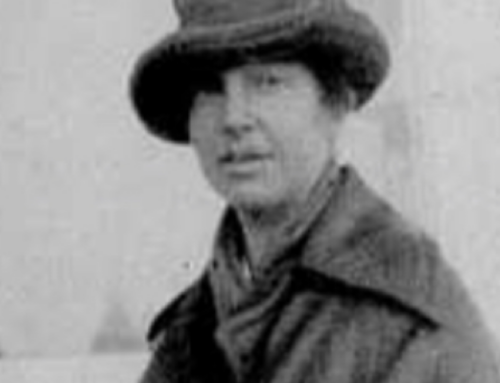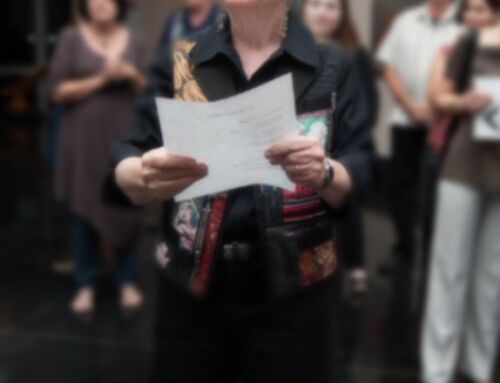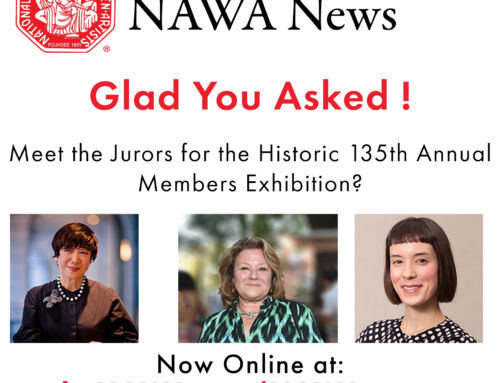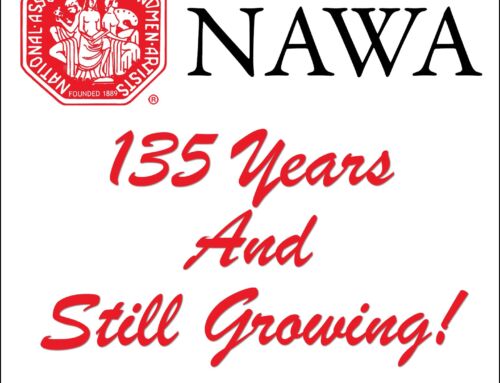NAWA Luminaries – Louise Nevelson
NAWA Luminaries is the intersection of the National Association of Women Artists’ historical research and current exhibitions around the United States highlighting celebrated NAWA members.

Louise Nevelson, 1976 , photo by Lynn Gilbert
Louise Nevelson
“I’m not a feminist. I’m an artist who happens to be a woman.” 1
The Art Students League currently exhibits Women in Construction in their Phyllis Harris Mason Gallery at 215 West 57th Street in New York. The thematic group show explores how 35 women-identifying artists literally and figuratively construct their identities through their artworks. The League’s acquisition of its first works by Louise Nevelson to its permanent collection inspired the exhibition.
Nevelson was active at the Art Students League from 1924 to 1934—a significant period in her life and career. Nevelson joined NAWA in 1952 and became an Honorary Vice President in 1984.
Louise Nevelson (September 23, 1899 – April 17, 1988) was an American sculptor known for her monumental, monochromatic, wooden wall pieces and outdoor sculptures.
She was born Leah Berliawsky on September 23, 1899, in Pereiaslav, Poltava Governorate, Russian Empire, to Minna[ Sadie and Isaac Berliawsky, a contractor and lumber merchant.2 Nevelson’s relatives had begun to leave the Russian Empire for America in the 1880s, but the Berliawskys had to stay behind, as Isaac, the youngest brother, had to care for his parents. While still in Europe, Minna gave birth to two of Nevelson’s siblings: Nathan (1898) and Anita (1902). Isaac emigrated to the United States in 1902 after his mother’s death, and Minna and the children moved to the Kiev area. In 1905, Minna and the children emigrated to the United States, joining Isaac in Rockland, Maine. Isaac worked as a woodcutter before opening a junkyard. His work as a lumberjack made wood consistently present in the family household. Eventually, he became a successful lumberyard owner and realtor, and another child, Lillian, was born in 1906. Nevelson was very close to her mother, who suffered from depression. Arguably compensating for their minority status as a Jewish family living in Maine, Minna dressed herself in flamboyant outfits with heavy make-up and the children in clothing “regarded as sophisticated in the Old Country.”3
Nevelson remembered her first art experience was at the age of nine at the Rockland Public Library, where she saw a plaster cast of Joan of Arc.4 Deciding to study art, she took drawing classes in high school. Using watercolor, she painted interior scenes in which furniture appeared molecular in structure, similar to her later professional work. Nevelson also frequently created female figures.
She graduated from high school in 1918 and began working as a stenographer at a local law office. There, she met Bernard Nevelson, co-owner with his brother Charles of the Nevelson Brothers Company, a shipping business. Bernard introduced her to his brother, and Charles and Louise Nevelson were married in June 1920 with a Jewish ceremony at the Copley Plaza Hotel in Boston. The couple moved to New York City, where she began to study painting, drawing, singing, acting, and dancing. In 1922, she gave birth to her son Myron (later called Mike) and continued studying art despite the disapproval of her parents-in-law.5
In 1924, the family moved to Mount Vernon, New York, and Nevelson was upset with the move, which removed her from city life and her artistic environment.6 She began her studies at the Art Students League and, in 1929, began studying art full-time. While at the League, Nevelson studied life drawing with some of the institution’s most well-known instructors: Hans Hofmann, Kenneth Hayes Miller, Kimon Nicolaides, and George Grosz. In 1931, she sent her son Mike to live with family and went to Europe, paying for the trip by selling a diamond bracelet that her husband had given her on the occasion of Mike’s birth.7 Nevelson studied with Hans Hofmann in Munich before visiting Italy and France. Returning to New York in 1932, she returned to the Art Students League. During the winter of 1932–1933, she separated from Charles.

Clown tight rope walker by Louise Nevelson, c. 1942 (John D. Schiff, photographer, Louise Nevelson papers, Archives of American Art, Smithsonian Institution)
Nevelson met Diego Rivera in 1933 and worked as his assistant on his mural Man at the Crossroads at Rockefeller Plaza. The two had an affair, causing a rift between Nevelson and Rivera’s wife, Frida Kahlo, an artist Nevelson greatly admired.8 Nevelson started taking sculpture classes at the Educational Alliance shortly after. Adding to her experimenting with lithography and etching, Nevelson began to focus on sculpture and worked with plaster, clay, and tattistone, a self-hardening material.
During the 1930s, Nevelson started to exhibit her work in group shows. In 1935, she taught mural painting at the Madison Square Boys and Girls Club in Brooklyn as part of the Works Progress Administration (WPA). In 1936, Nevelson won her first sculpture competition at the A.C.A Galleries in New York.
In the 1940s, she began producing Cubist figure studies in stone, bronze, terra cotta, and wood. She gathered materials from junkyards and city streets and constructed sculptures, adding pieces to one another.
In 1941, Nevelson had her first solo exhibition at Nierendorf Gallery, representing her until 1947. An article about her appeared in Art Digest in November 1943, describing her “emotionally colored and slippery pigmented portraits” reminiscent of Soutine.9 In that same year, she had a show at Norlyst Gallery called The Clown as the Center of His World, in which she constructed sculptures about the circus from found objects. The show was not well received, and Nevelson stopped using found objects until the mid-1950s. Despite the poor reception, Nevelson’s works at this time explored both figurative abstracts inspired by Cubism[ and surrealism’s exploitative and experimental influence. Nevelson exhibited her work in Peggy Guggenheim’s show Exhibition by 31 Women at the Art of This Century gallery in New York in 1943.
Nevelson found commercial success only after she began painting her constructions with a single color in the 1950s. Using color—first black, later white, and then gold—would become essential to Nevelson’s work. In That Silent Place (1954–55), she arranged wooden blocks so that their imperfections helped create a relationship among the parts. A few pieces lean to one side, while others are not square, the holes meant for screws, nails, or dowels remaining empty. Nevelson arranged these elements into a pattern of structure and void, evoking a cityscape.

1954 NAWA Annual Membership Exhibition, Honorable Mention, Rutgers Library
During the 1950s, despite exhibiting her work as often as possible and winning awards and popularity with art critics, she struggled financially. She began teaching sculpture classes in adult education programs in the Great Neck public school system. Her work grew to a monumental size, moving beyond the human-scale works of the early 1940s.
Nevelson joined NAWA in 1952, exhibiting consistently in the annual membership exhibitions through 1961. In 1953, she received the Mr. and Mrs. Henry J. Gaisman Prize for The Ancient Figures, and in 1954, Honorable Mention for Figure from the Great Beyond.
In 1954, Nevelson’s street in Kips Bay was among those slated for demolition and redevelopment, and her increasing use of scrap materials in the years ahead drew upon refuse left on the streets by her evicted neighbors. In 1955, Nevelson joined Colette Roberts’ Grand Central Modern Gallery, where she had numerous one-woman shows. It was where she exhibited some of her most notable mid-century works: Bride of the Black Moon, First Personage, and the exhibit “Moon Garden + One,” which showed her first wall piece, Sky Cathedral, in 1958.
A critic for Art News described NAWA’s 1956 annual as being “modern… cheerful, candid and unpretentious” 10 Sculpture was singled out for particular praise, particularly entries by Louise Nevelson and Dorothea Greenbaum. Nevelson was given the NAWA Medal of Honor in 1959 for Night Personage. Nevelson again received special mention in Art News in 1959 for her “prize-winning column.” According to the critic, it asserted a “quiet dominance” over the sculpture gallery. Once again, the sculpture section, in general, was praised and described as outweighing the others “in impact and importance?”11 Nevelson’s exposure in these annual shows helped launch her career and establish her as one of America’s leading sculptors of the 20th century.12 Shortly after receiving accolades such as those mentioned above, one of her works, Sky Cathedral, was exhibited at the Museum of Modem Art (1958), and in 1958-59, Dorothy Miller included her work in one of the anthologies of the New American Art that she curated for that Museum.

1959, NAWA Medal of Honor, NAWA Archives, Rutgers Library
From 1957 to 1958, Nevelson was president of the New York Chapter of Artists’ Equity, where she forged a long friendship with Norman Carton, a former Philadelphia Artist Equity president. In 1958, Carton helped Nevelson join the Martha Jackson Gallery, where he worked and exhibited.13 At Martha Jackson, Nevelson was guaranteed income and became financially secure. That year, she had her first Martha Jackson solo exhibit and was photographed and featured on the cover of Life.14
In 1960, Nevelson won NAWA’s M. Grumbacher Artists’ Material Company Award for Column. That same year, she had her first one-woman show in Europe at Galerie Daniel Cordier in Paris, and a collection of her work, grouped as Dawn’s Wedding Feast, was included in the group show “Sixteen Americans” at the Museum of Modern Art. Dawn’s Wedding Feast filled an entire gallery with wall constructions, freestanding and hanging columns, and other elements reminiscent of architectural forms.15
In 1962, Nevelson made her first museum sale to the Whitney Museum of American Art, which purchased the black wall Young Shadows. Her work was selected for the 31st Venice Biennale, and she became national president of Artists’ Equity, serving until 1964. Nevelson left Martha Jackson Gallery in 1962 for a brief stint at the Sidney Janis Gallery. After an unsuccessful first show in which none of her work sold, Nevelson had a falling out with gallery owner Janis over sums he advanced her and could not recoup. A contentious legal battle left Nevelson broke, depressed, and at risk of becoming homeless. A funded, six-week artist fellowship at Tamarind Lithography Workshop (now Tamarind Institute) in Los Angeles provided an escape from the drama of New York City. She explained, “I wouldn’t ordinarily have gone. I didn’t care so much about the idea of prints at that time but I desperately needed to get out of town and all of my expenses were paid.”16
Nevelson has been described as spontaneous when she worked, often making decisions as she made her compositions,17 no matter the medium. Fellowships at the Tamarind Lithography Workshop in Los Angeles in 1963 and 1967 were an opportunity to explore printmaking. Her lithographs used materials and methods uncommon in printmaking but consistent with assemblage, such as using fabrics and cut paper to create compositions on the plate.
Nevelson returned to New York and joined Pace Gallery in the fall of 1963, where she had shows regularly until the end of her career. In 1964, she created two works, Homage to 6,000,000 I and Homage to 6,000,000 II, both tributes to victims of The Holocaust. In 1967, the Whitney Museum hosted the first retrospective of Nevelson’s work. The exhibit comprised over one hundred pieces, including drawings from the 1930s and contemporary sculptures. By this time, Nevelson had solidified commercial and critical success.

1960, NAWA M. Grumbacher Artists’ Material Company Award, NAWA Archives, Rutgers Library
Even in the late years of her practice, Nevelson continued experimenting with new approaches and mediums, from embossing thin plates of lead to designing sculptures in aluminum and Plexiglass to generating public art projects in weathering steel. “It is not the medium that counts,” Nevelson said. “It is what you see in it and what you do with it.” 18
In the fall of 1969, Princeton University commissioned Nevelson to create her first outdoor sculpture. Nevelson reminisced about this time in her life and work: “Remember, I was in my early seventies when I came into monumental outdoor sculpture … I had been through the enclosures of wood. I had been through the shadows. I had been through the enclosures and come out into the open.”19
New materials like Plexiglas and cor-ten steel offered new opportunities, and she welcomed the idea of her works being able to withstand climate change and the freedom to work without constraining limitations in size. Nevelson’s public art commissions were a monetary success, and in 1969, she was awarded the Edward MacDowell Medal.
In 1972–1973, she created her Dream Houses sculptures, using small pieces of wood assembled into house shapes and characteristically painted black. Unlike many of her other works, which incorporated a single façade, these were fully three-dimensional. In 1973, the Walker Art Center curated a major exhibition of her work, which traveled for two years. In 1975, she designed the chapel of St. Peter’s Lutheran Church in Midtown Manhattan. That same year, she created and installed a large wood sculpture titled Bicentennial Dawn at the new James A. Byrne United States Courthouse in Philadelphia.
During the last half of her life, Nevelson solidified her fame and persona by cultivating a style for her “petite yet flamboyant” self20 that contributed to her legacy: dramatic dresses, scarves, and large false eyelashes.21 The designer Arnold Scaasi created many of her clothes.
Nevelson continued to create sculptures during the 1980s, and in 1984, NAWA invited her to become an Honorary Vice President. Nevelson died on April 17, 1988.
Nevelson’s work is included in museum collections worldwide, such as the Pérez Art Museum in Miami, Florida; Smithsonian American Art Museum, Washington DC; Tate, London; the Whitney Museum of American Art, Brooklyn Museum, Museum of Modern Art, New York; and the Guggenheim Museum.
In 2005, Maria Nevelson, the youngest granddaughter, established the Louise Nevelson Foundation, a non-profit 501c(3). Its mission is to educate the public and celebrate the life and work of Louise Nevelson, thus furthering her legacy and place in American Art History. Maria Nevelson lectures widely about her grandmother at museums, has participated in NAWA events, and provides research services.
Sources:
3https://www.aaa.si.edu/collections/louise-nevelson-papers-9093/series-6
9https://www.aaa.si.edu/collections/items/detail/art-digest-9774
https://americanart.si.edu/artist/louise-nevelson-3523
11 https://www.artforum.com/interviews/jonathan-lippincott-talks-about-large-scale-28086.
Bryan-Wilson, Julia (2017). “Keeping House with Louise Nevelson”. Oxford Art Journal. 40 (1). Oxford University Press: 109–131.
14 Di Marzo, Cindi (2007). “Louise Nevelson: The Artist and the Legend”. Studio International.
16Glimcher, Arnold B. (1972). Louise Nevelson. New York: Praeger Publishers. pp. 12–14.
15H.D.H., Sixty-Seventh Annual, Art News 58, no.4 (June 1959),19.
18Holmes, Ann, “For Nevelson, It’s Not the Medium, But What You ‘See,'” Houston Chronicle, October 23, 1969.;
https://www.jewishvirtuallibrary.org/louise-nevelson
1, 10L.C., NAWA, Art News, 55, no.4 (June 1956),p.54.
Lisle, Laurie (1990). Louise Nevelson: A Passionate Life. New York: Summit Books. pp. 236–239.
Louise Nevelson papers, circa 1903–1979″. Archives of American Art. Smithsonian Institution.
13,17 https://www.moma.org/artists/4278#fn:5
12 Pisano, Ronald, The National Association of Women Artists, One Hundred Years, A Centennial Celebration of the National Association of Women Artists.
1,.5,6,19,20Rapaport, Brooke Kamin (2007). The Sculpture of Louise Nevelson: Constructing a Legend. New York: Jewish Museum of New York.
Rubinstein, C.S., (1982). American Women Artists, Avon Books.
7,8Seaman, Donna (2008). “The Empress of in-between: A Portrait of Louise Nevelson”. TriQuarterly. 9 (31): 280.
15 Taggart, Hollis (December 8, 2021), Norman Carton at The Martha Jackson Gallery, 1958
21https://www.theartstory.org/artist/nevelson-louise/
Van Riper, Kate, Archivist for Women Artists’ Collections, Special Collections and University Archives, Rutgers University Libraries, NAWA Archives
2https://en.wikipedia.org/wiki/Louise_Nevelson
Susan M. Rostan, M.F.A , Ed.D. Co-Chair: NAWA Historical Research. Website
Signature Member of the National Association of Women Artists
Historian, Co-Chair NAWA Historical Research. NAWA Luminaries
Email: NAWA Historian
NAWA. Empowering Women Artists Since 1889







































